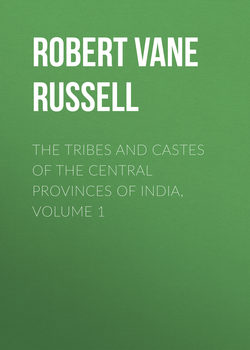Читать книгу The Tribes and Castes of the Central Provinces of India, Volume 1 - Robert Vane Russell - Страница 32
Part I.
Introductory Essay on Caste
Introductory Essay on Caste
29. Other village traders and menials
ОглавлениеThe castes following other village trades mainly fall into this group, though they may not now be village menials. Such are the Kalār or liquor-vendor and Teli or oil-presser, who sell their goods for cash, and having learnt to reckon and keep accounts, have prospered in their dealings with the cultivators ignorant of this accomplishment. Formerly it is probable that the village Teli had the right of pressing all the oil grown in the village, and retaining a certain share for his remuneration. The liquor-vendor can scarcely have been a village menial, but since Manu’s time his trade has been regarded as a very impure one, and has ranked with that of the Teli. Both these castes have now become prosperous, and include a number of landowners, and their status is gradually improving. The Darzi or tailor is not usually attached to the village community; sewn clothes have hitherto scarcely been worn among the rural population, and the weaver provides the cloths which they drape on the body and round the head.64 The contempt with which the tailor is visited in English proverbial lore for working at a woman’s occupation attaches in a precisely similar manner in India to the weaver.65 But in Gujarāt the Darzi is found living in villages and here he is also a village menial. The Kachera or maker of the glass bangles which every Hindu married woman wears as a sign of her estate, ranks with the village artisans; his is probably an urban trade, but he has never become prosperous or important. The Banjāras or grain-carriers were originally Rājpūts, but owing to the mixed character of the caste and the fact that they obtained their support from the cultivators, they have come to rank below these latter. The Wanjāri cultivators of Berār have now discarded their Banjāra ancestry and claim to be Kunbis. The Nat or rope-dancer and acrobat may formerly have had functions in the village in connection with the crops. In Kumaon66 a Nat still slides down a long rope from the summit of a cliff to the base as a rite for ensuring the success of the crops on the occasion of a festival of Siva. Formerly if the Nat or Bādi fell to the ground in his course, he was immediately despatched with a sword by the surrounding spectators, but this is now prohibited. The rope on which he slid down the cliff is cut up and distributed among the inhabitants of the village, who hang the pieces as charms on the eaves of their houses. The hair of the Nat is also taken and preserved as possessing similar virtues. Each District in Kumaon has its hereditary Nat or Bādi, who is supported by annual contributions of grain from the inhabitants. Similarly in the Central Provinces it is not uncommon to find a deified Nat, called Nat Bāba or Father Nat, as a village god. A Natni, or Nat woman, is sometimes worshipped; and when two sharp peaks of hills are situated close to each other, it is related that there was once a Natni, very skilful on the tight-rope, who performed before the king; and he promised her that if she would stretch a rope from the peak of one hill to that of the other, and walk across it, he would marry her and make her wealthy. Accordingly the rope was stretched, but the queen from jealousy went and cut it nearly through in the night, and when the Natni started to walk, the rope broke, and she fell down and was killed. Having regard to the Kumaon rite, it may be surmised that these legends commemorate the death of a Natni or acrobat during the performance of some feat of dancing or sliding on a rope for the magical benefit of the crops. And it seems possible that acrobatic performances may have had their origin in this manner. The point bearing on the present argument is, however, that the Nat performed special functions for the success of the village crops, and on this account was supported by contributions from the villagers, and ranked with the village menials.
64
See article Darzi for further discussion of the use of sewn clothes in India.
65
See articles on Bhulia, Panka, Kori and Julāha.
66
Traill’s Account of Kumaon, Asiatic Researches, vol. xvi. (1828) p. 213.
